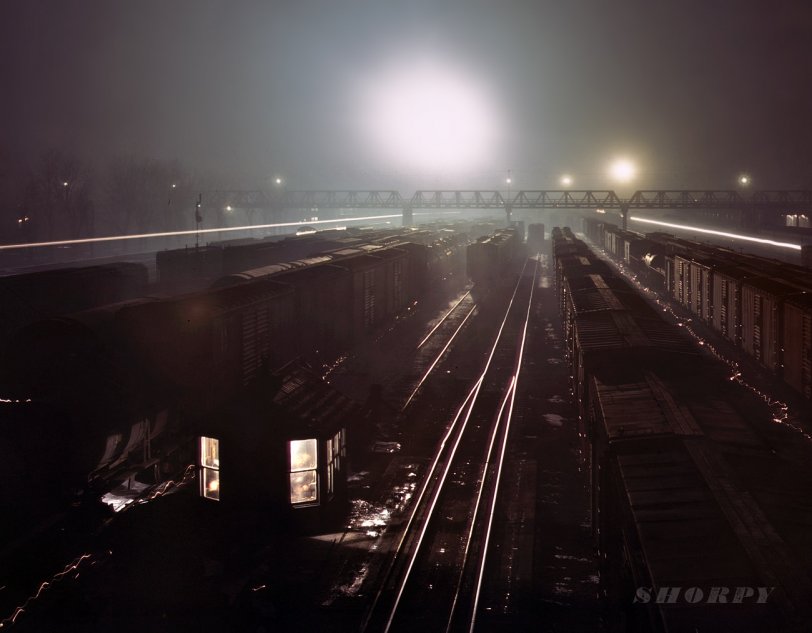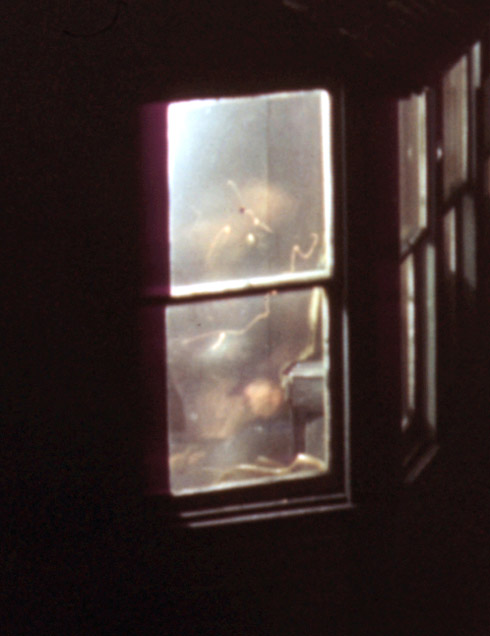


Framed or unframed, desk size to sofa size, printed by us in Arizona and Alabama since 2007. Explore now.
Shorpy is funded by you. Patreon contributors get an ad-free experience.
Learn more.

- Indiana Harbor Belt abides
- Freezing haze
- Corrections (for those who care)
- C&NW at Nelson
- Fallen Flags
- A dangerous job made worse
- Water Stop
- Passenger trains have right of way over freights?
- Coal
- Never ceases to amaze me.
- Still chuggin' (in model form)
- Great shot
- Westerly Breeze
- For the men, a trapeze
- Tickled
- Sense of loneliness ...
- 2 cents
- Charm City
- What an Outrage
- Brighton Park
- Catenary Supports
- Just a Little Before I was Born
- Afternoon normal
- The Flat Iron Cafe survives
- Aging in Place
- Raise your hand
- Good and Bad
- Oh, the 70's
- Nooooooi
- The aluminum tubing
Print Emporium
Night Train: 1943

March 1943. The Santa Fe Yards at Argentine, Kansas. View full size. 4x5 Kodachrome transparency by Jack Delano, Office of War Information.
Probably east of 42nd Street
Based on the recently-posted photo at https://www.shorpy.com/node/14960 , I think this is on the east side of 42nd Street (the bridge in the background), looking west. The blur of white in the top center of this photo is from the light tower seen at the upper right of 14960, and the trees at the upper left in this photo seem to match the ones on the east side of 42nd Street (by the big warehouse) in 14960.
Today, there is a small shack, and a larger BNSF building, in the general area. http://maps.google.com/maps?ll=39.081542,-94.675506&spn=0.002361,0.00324...
Time travel.
You realize these old Kodachromes are time travel machines, don't you?
Old B/W photos are like looking into a history book. Many washed out old color photos are the same.
These old Kodachromes take you back to the instant they were made. You're standing right there, peeking in on others and half expecting them to look right back.
Night Train 1943
Re: Kodachrome. I took a night photo in Rome in 1958 with ASA 10 Kodachrome. The camera was on a tripod, exposure was on the button at 30 sec. @ f 2.8. If this 4x5 was shot, say, at f8, it would have been, as Dave says, 5 to 7 minutes, plenty of time to record the lanterns of the walkers and the cigarettes of the men in the railhouse. Shooting with slow films was a challenge, but not as daunting as you might think. You could hand-hold in daylight, 5.6 at 1/60th, or even 1/100th in bright sun. My 50+ year-old Kodachromes are as good as new, but not so with Ektachromes, which are all red now, and Anscochromes, which have just faded away.
Railhouse Is...
In case you are wondering just what the "railhouse" is, its a scale track that weighs freight cars when they are diverted on the track that runs just in front of the windows.
A theory about the lighting
The exposure was fifteen minutes or so, but the railhouse lights were turned on for only a small portion of that. I can't figure out any other way you would see both the lantern-trail on the right and distinct figures in the house.
If so, I wonder if this was arranged with the yard workers. Did Jack Delano tell them to leave the lights off until he called down to them?
[Close up, we can see the figures in the railhouse (below) are a blur -- with a light trail from someone's cigarette. I don't think anyone was turning lights off or on. We know that some of Delano's nighttime exposures were around five to seven minutes. - Dave]

Very long exposure
Look at the meandering light streak on the right, clearly a lantern or flashlight being swung in the hand of somebody walking through the frame. The shutter had to be open for several minutes at least for him to walk so far.
The more I look at this picture, the more I love it.
[Plus, a cigarette! See above. - Dave]
Night Train: 1943
This looks like a painting. Look at the rail house the figures in it look painted not real
Love it!
Perfect exposure. I wonder how many takes it took him to get it right.
[This one took some Shadows & Highlights tweaking in Photoshop. - Dave]

Wow, gorgeous.
That's one for the desktop background. Talk about atmospherics.
























On Shorpy:
Today’s Top 5